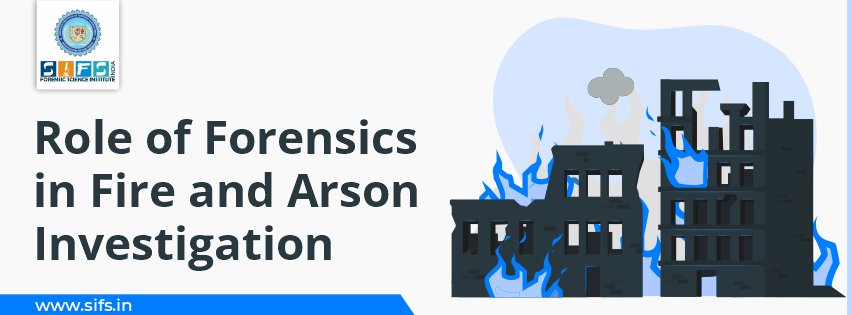- Call Us: +91 7303913002
- Email Us: education@sifs.in
Role of Forensics in Fire and Arson Investigation

BY SIFS India | October 12, 2020
Role of Forensics in Fire and Arson Investigation
Frequently we see news alerts, regarding house fires, industrial fires, bush fires, arson crimes, fire rescues, and evacuation. The question always raised is, Was it arson? Where did the fire start?
Fire
As we all know that fire can destroy houses and all possessions in less than an hour. It can reduce an entire forest to a pile of ash and charred remains. Fire kills more people every year than any other force of nature. But on the other hand, fire is also helpful in our daily life in many ways.
Chemistry of Fire
Fire is uncontrolled combustion. It involves combustible materials which are found around us. It involves the oxidation of fuel and emits energy in terms of heat and radiation.
Therefore, fuel, oxygen, and heat are the three basic essential components to initiate fire. Any chemical substance (solid, liquid or gas) used to start a fire or increase the intensity or speed is known as fuel.
Progress of Fire
The notable ones are:
• Availability of combustible material and oxygen
• Temperature of fire
• Humidity
• Direction and velocity of wind
Fire and Arson Investigation
Arson is quite frequently committed mala fide crimes. According to the definition, arson is conscious lighting of a fire, it is a crime of intentionally, deliberately, and maliciously setting fire to buildings, wildland areas, houses, vehicles or other property with the intent to cause damage.
What Does The Arsonist Tries to Achieve?
Arson being a malicious set up of fire, the arsonist would try to achieve:
- Proper Initiation
- Quick spread
- Complete destruction
The culprit uses various devices and materials for initiation:
- It could be a flame through a matchstick
- Any explosive and incendiary materials
- A simple crackers
- Chemicals
- Heating appliances
- Inflammable liquids such as petrol, kerosene oil, diesel, alcohol etc
What Could be The Motives of a Arsonist?
The motives of fire setting behavior could be:
- Vandalism
- Excitement
- Revenge
- Crime concealment
- Profile
- Extremism
Forensic Investigation of Arson
The fire and arson investigators examine the fire scene, identify and collect the physical evidence from the scene.
The evidence, found could be accelerants, fire debris, materials used for initiation etc. A very important part is proceeding with the analysis itself, that is sample collection. T
he samples have to be collected from the place where the fire started. Because there may be traces of accelerant possibly found. A fire may be put off too quickly or due to oxygen shortage, at the point of arson.
So in that cases, the chemical analysis of fire debris can tell us what kind of accelerants was used to initiate the fire.
What Precautions Should Take for Samples Storage?
The most important part is samples storage: Containers which is used for samples storage have to be air tight and clean, to avoid any loss and contamination.
Bags and containers made up of polythene cannot be used because they can emit some type of impurities. So the best and most frequently used are air-tight metal cans.
Arson Investigation Instrumental Techniques for Analysis of Accelerants from Debris
Head Space Analysis
GCMS ( Gas Chromatography-Mass Spectroscopy)
It is an extremely versatile approach, In this compounds are separated on the basis of their relative affinity with the stationary phase of the column. GCMS is commonly used for the analysis of petroleum products residues in fire debris.
TLC ( Thin Layer Chromatography)
Chromatography is the modern and versatile method used for the separation of organic compounds. TLC involves the separation of the components of a mixture over a thin layer of an adsorbent.
HPLC (High-Performance Liquid Chromatography)
It is a unique separation technique for separation of organic components of mixture. It is used for detection of separated organic compounds based on different interaction of analysis between liquid phase passing through a column.
FTIR ( Fourier Transform Infrared Spectroscopy)
It is most useful for identifying chemicals either organic or inorganic, in which the data is collected and converted, and interference pattern to a spectrum.
References
Bumrah, Sarin and R. N. Sharma. “Analysis of petroleum products in fire debris residues by Gas Chromatography. ” Arab journal of Forensic Science 1(2017) :560-513
Lentini, J. J. “Scientific protocol for fire investigation”(2006)
National Institute of Justice nij. ojp. gov

